What are western bean cutworms?
Western bean cutworm (Striacosta albicosta) is an economic pest in dry bean and corn production. Despite its name, western bean cutworm (WBCW) does not naturally feed on field soybeans.
WBCW is native to North America, but the pest’s geographical range has expanded eastward since 1999. WBCW was first detected in Wisconsin in 2004.
Adult moths do not damage corn, but the larvae feed on tassels, silks, and corn ears, causing reduced grain quality and yield. Secondary pathogens and mold are frequently associated with ear feeding damage.
What do western bean cutworms look like?
Egg: Egg masses (~20-200 eggs) are laid on vertically oriented, new corn leaves. Eggs may be found close to ears or on husks if the corn has already silked (R1). Freshly laid eggs are white and become tan during development. Prior to hatching, the eggs become purple.
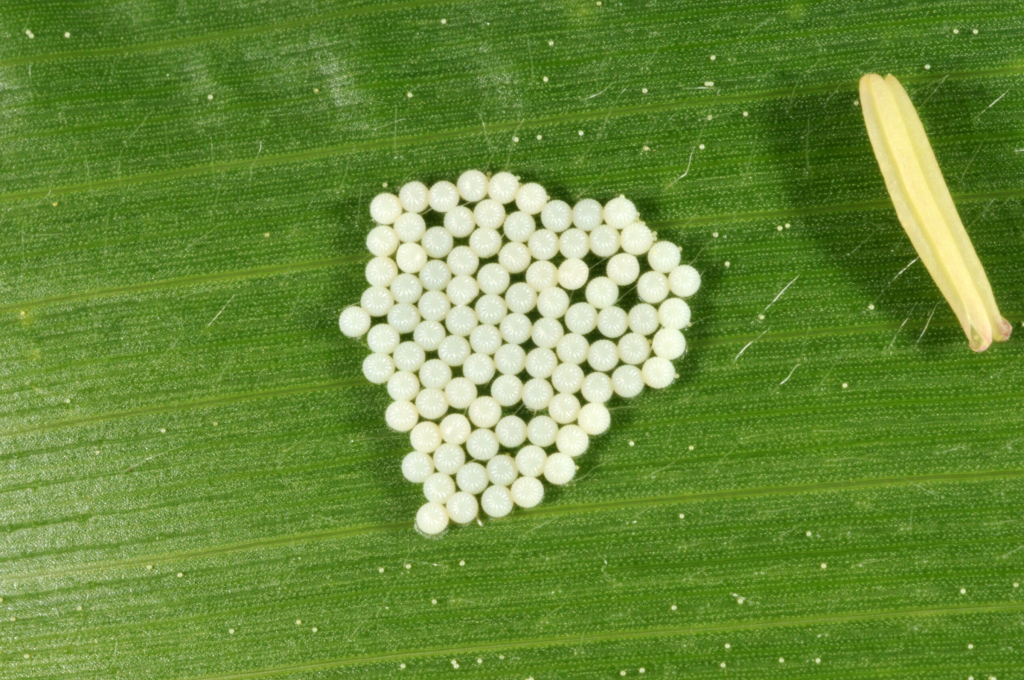

Larvae: Newly hatched larvae are purple with black heads. As they develop, larvae become tan and longitudinal stripes become noticeable. In the fourth instar, WBCW becomes easily distinguishable from other larvae by the two black rectangles behind the head. The larvae reach 1.5 inches long when fully grown.
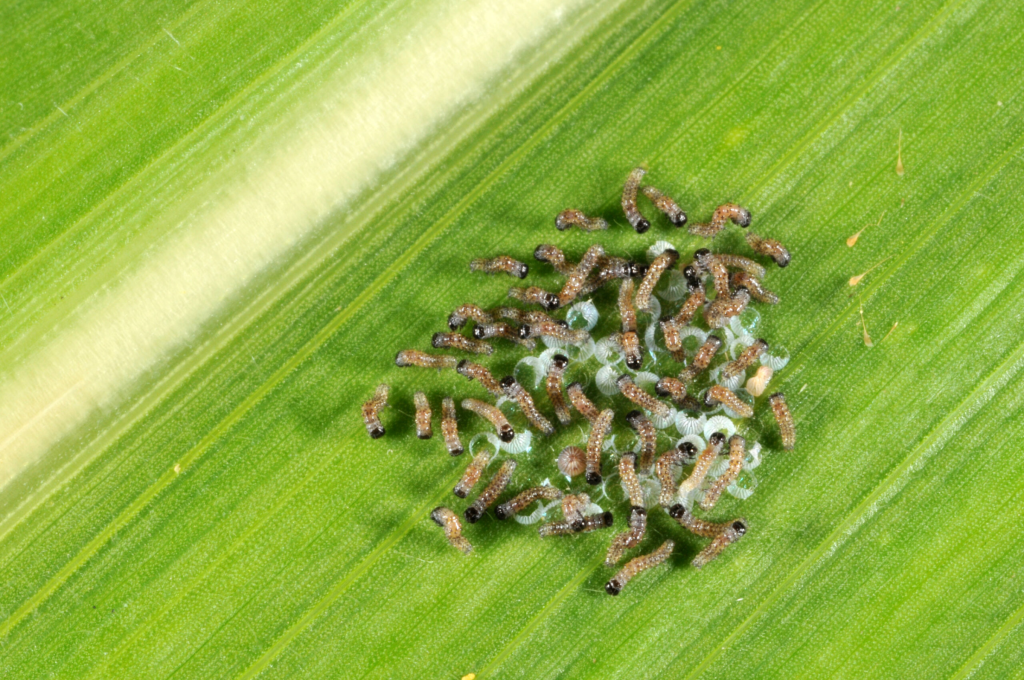

Adult: Moths are about 3/4 inch long and gray to brown in color. Male and female moths have distinguishable cream-colored stripes along the outer edge of the forewing, circular spots in the center of each forewing, and a boomerang-shaped mark near the tip of the forewing.
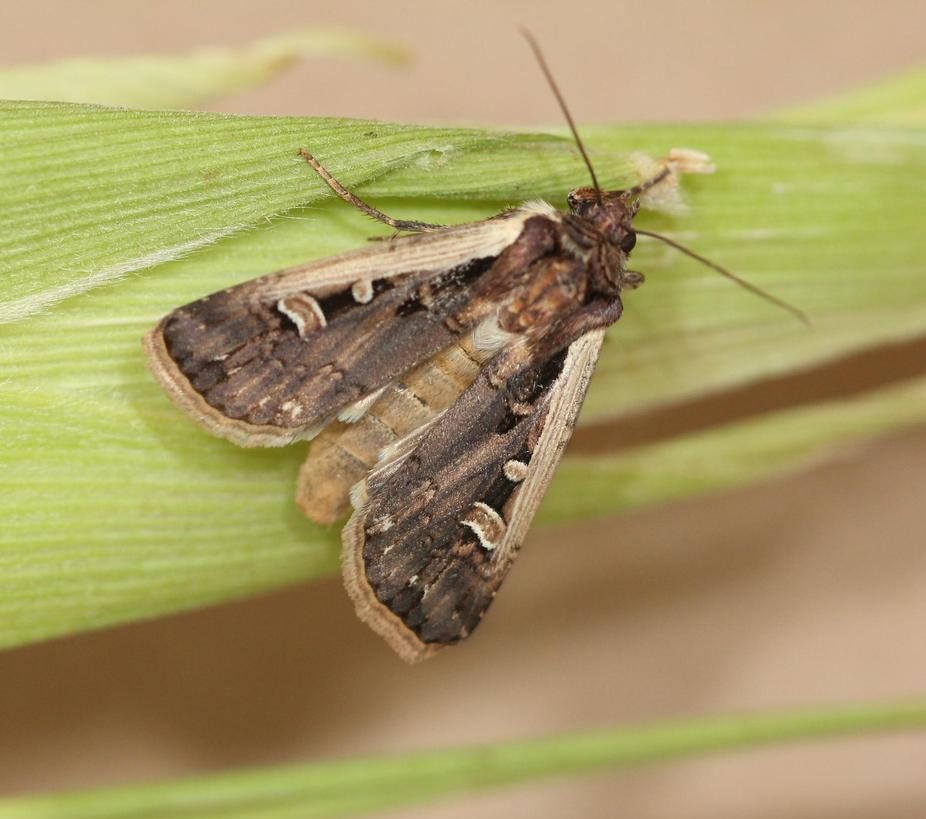
WBCW moths can commonly be confused with spotted cutworm, yellow-striped armyworm and dingy cutworm.
What are the life cycle and biology of western bean cutworms?
WBCWs complete one generation per year in Wisconsin. Flights begin in early June, peaking in mid-July to early-August. Adult flight timing is impacted by climate and location, and differs across northern, central, and southern Wisconsin.
DATCP reported the first western bean cutworm moths of 2024 during the week of June 14th. The peak flight period is 1,422-degree days, indicating when half of the season’s WBCW moth population will have emerged.
Adult moths fly in early June, mate, and deposit eggs in corn. Female moths prefer laying eggs in corn just prior to tasseling. The eggs hatch and larvae feed on tassels, silks, and kernels, depending on the growth stage of the corn host. Before tassel emergence, larvae feed on pollen in the whorl. After tassel emergence, larvae feed on the silks, ear, or husk. The larvae are mobile and can move between plants and across rows, often resulting in widespread infestation. The sixth instar leaves the plant and enters the soil, burrowing between 12-25 cm into the earth. The larvae create a soil chamber and overwinters in a pre-pupal stage. WBCWs pupate in the spring when temperatures exceed 50°F and emerge as adult moths around late-June to early-July, depending on degree day heat unit accumulation.
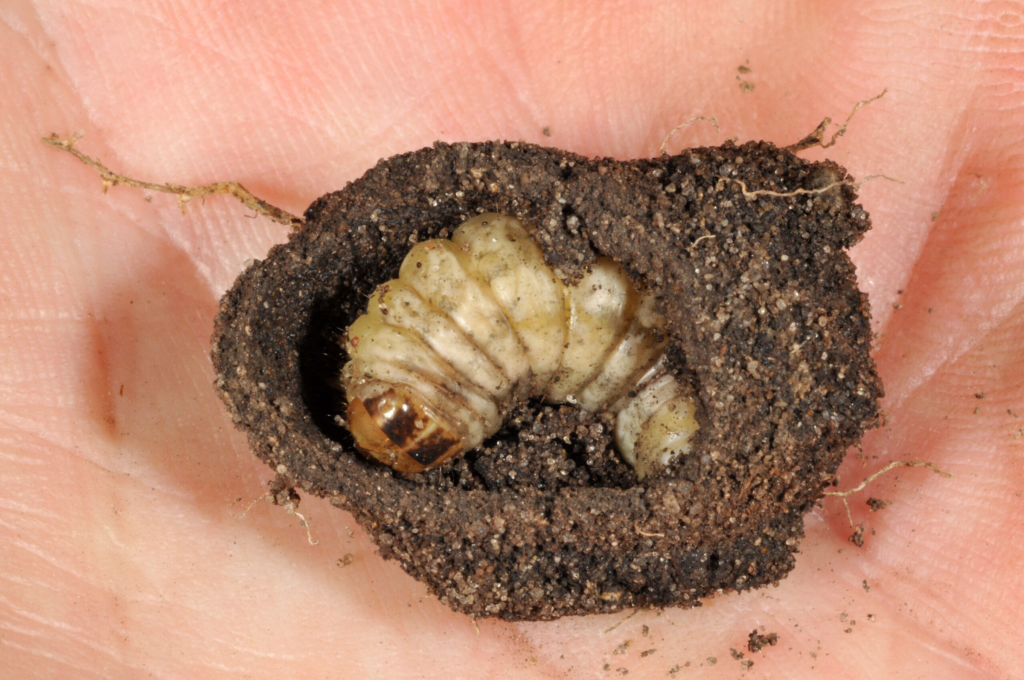
What are the symptoms of western bean cutworm damage?
WBCW, unlike other cutworms, does not chew stems or leaves. The insect feeds on silks, tassels, and kernels. Damage is often concentrated on the ear.
WBCW infestations may be difficult to identify during the field season, but you should look for clipped silks and check ear tips for feeding damage and frass. Holes in the husks may also be visible.


WBCW feeding can increase chances for ear mold infection and mycotoxin contamination caused by fungi like Fusarium graminearum. This directly impacts grain quality, and fungi mycotoxins can negatively impact livestock health if corn is being used for feed.

How do you scout for western bean cutworms?
Monitoring for adult moths can be done with pheromone or black light traps. The presence of moths indicates it is time to scout for eggs and larvae in your field. DATCP has a trapping network in Wisconsin, and moth flights can be found here.
Degree days can be used to estimate adult emergence, egg-laying, and larval hatch in the field.
Once WBCW degree-day accumulation indicates 25% moth emergence or when the first moths are detected in a pheromone trap in your area, scout a minimum of 20 consecutive plants in 5 locations in a corn field for egg masses and larvae. Look for egg masses on the upper surfaces of new leaves and leaves that haven’t unfolded above and below the ear zone. Look for young larvae on leave axils, tassels and silks.

What is the threshold to reach for western bean cutworm treatment?
For field corn, treat when 5% of plants scouted have egg masses or small larvae.
For processing sweet corn, treat when 4% of plants scouted have egg masses or small larvae.
Integrated pest management (IPM) strategies for western bean cutworms
Cultural Control: Deep soil tillage may impact western bean cutworms as they overwinter as prepupae, but studies have not directly tested the impact of soil disturbance on mortality.
Biological Control: Lady beetles, minute pirate bugs, lacewing larvae, and ground beetles are predators of WBCW eggs and young larvae. WBCW is also impacted by a parasitoid wasp (Trichogramma sp.) and a microsporidium (Nosema spp.). Birds, racoons, and skunks are also known to be predators of older larvae and pupae.
Transgenic corn is an option for WBCW management in field corn. Not all proteins will control WBCW at high populations. For more details, see the Transgenic BT Corn section in A3646.
Chemical Control: Pyrethroids are widely used for WBCW control in the United States. Refer to A3646: Pest Management in Wisconsin Crops, for western bean cutworm insecticide recommendations in corn.
Application timing is critical. Foliar insecticides are effective only if they are applied before larvae enter the ear. Once larvae are inside the ear, they’re protected from foliar insecticides.
If plants have tasseled but eggs have not hatched, target insecticide application close to expected egg hatch. If eggs have hatched, target application after 95% tassel emergence but before the larvae enter the silks.
Western bean cutworm response and management options
Monitor weather conditions and crop growth stage to determine optimal timing for insecticide applications, as needed.
Always apply insecticides according to label instructions and consider factors such as application method, rate, and pre-harvest intervals.
Consider alternative management practices in severely infested fields.
Environmental and ecological considerations for western bean cutworm
Minimize pesticide use whenever possible to reduce potential impacts on non-target organisms, biological control organisms, and environmental health.
Implement IPM practices that promote biological diversity and ecosystem resilience.
References
Additional resources
For assistance with western bean cutworm management and other agricultural pest issues, contact your local agricultural extension office or entomology expert.


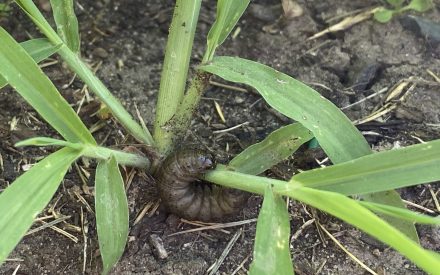 Managing Black Cutworm in Wisconsin Corn Fields
Managing Black Cutworm in Wisconsin Corn Fields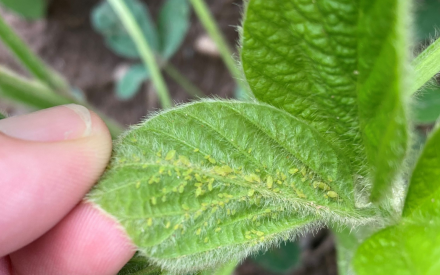 Managing Soybean Aphids in Wisconsin Soybean Fields
Managing Soybean Aphids in Wisconsin Soybean Fields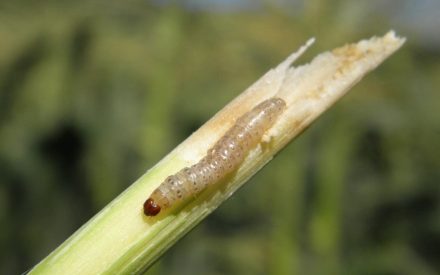 Managing European Corn Borer in Wisconsin Corn Fields
Managing European Corn Borer in Wisconsin Corn Fields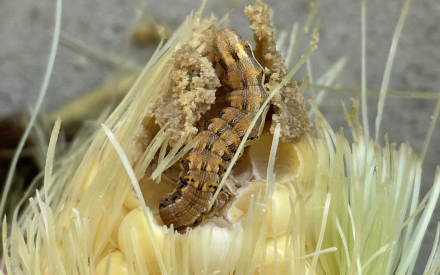 Managing Corn Earworm in Wisconsin Corn Fields
Managing Corn Earworm in Wisconsin Corn Fields


